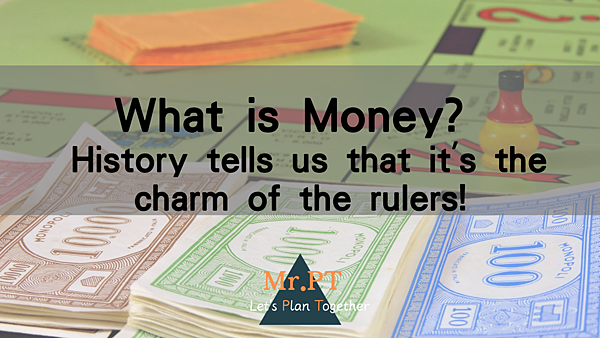Welcome to Mr. PT's 100 Financial Management classes, where you will learn about financial management courses that schools have never taught you.
Have you ever played Monopoly? Have you ever wanted more and more money inside the game? But if the day after the game ends, I suddenly take out the Monopoly money and want to exchange it for your breakfast, would you ignore me?
Is Monopoly money trash? If it is trash, why do people still flock to play the game?
Is real US dollars trash? Definitely not, because the whole world still plays the game with US dollars.
What do you think the currency in reality is? Let me tell you.
History of currency
Stage 1: Long, long ago, people used barter, and there was no internet, no trucks, and no railways at that time. People could only exchange goods nearby.
Mr. A: I will give you 5 chickens for 1 sheep.
Mr. B: Deal.
The next day
Mr. B wanted to eat rice, so...
Mr. B: I will exchange 1 sheep for 3 bags of rice.
Mr. C: No, I only have 2 bags of rice.
Mr. B, because he really wanted to eat rice, had to exchange with Mr. C.
The day after that
Mr. C saw Mr. A.
Mr. C: Mr. A, do you still have any chickens? How about I exchange 1 bag of rice with you for 1 chicken?
Mr. A: Okay, let's exchange!
What can we see from this story?
-
The value of goods is not always the same: If one sheep can be exchanged for 5 chickens or 2 bags of rice, then 2 bags of rice should be able to be exchanged for 5 chickens. In other words, 1 bag of rice should be exchanged for 2.5 chickens!
-
You need something to exchange: You have to carry rice, chickens, and sheep every day to exchange for other daily necessities. What if the rice has not yet been harvested?
Stage 2: Can shells also be exchanged for things? Until the emperors unified currency.
Carrying food every day was too inconvenient, so other things were used as substitutes at the beginning. Shells were used at first, but because there were too many types of shells and they were easy to counterfeit, leaders had to find other ways.
After unifying China, Emperor Qin Shihuang unified currency, and only the royal family and government could print currency. Because of the unified currency, trading between regions also became easier.
However, there are also disadvantages to the government printing currency. In German history after World War I, for example.
After losing the war, Germany began printing large amounts of German banknotes to pay war reparations, and the result of the mass printing was that people who had German-issued currency became increasingly poor.
Why did they become increasingly poor? Imagine you originally had 100 German marks. The government kept printing and gave 10 million to other countries. Then, other countries would bring the 10 million back to Germany to buy their food and land. The result was that the value of German marks fell, and people's money became worthless.
What can we learn from this story?
-
The value of currency is determined by the issuing authority.
-
The scarcity of goods determines their value, and only things that cannot be easily replicated can exchange for equivalent value (such as land or chickens).
-
It is crucial to stay connected with international developments and be aware of what other countries are doing.
Stage Three: The Gold Standard
Using gold and silver coins as exchange currency began in stage two. However, after World War II, the currency market was redefined due to the strength of the United States. The U.S. president said at the time, "One ounce of gold is equal to $35. Are we all in agreement?" The other presidents of the world responded, "How can we disagree...we don't want to be beaten up!" Under these circumstances of a global economic recession, everyone signed the agreement.
By 1971, another U.S. president said, "We no longer want this agreement," so the United States started printing money to save its economy and finance infrastructure and social welfare programs. This has caused problems for other countries because they received U.S. dollars based on the agreed-upon gold standard, but now only the United States can print U.S. dollars, making other countries' U.S. dollars worth less.
In 2023, one ounce of gold can be exchanged for $2000, indicating that the U.S. dollar has depreciated by 98% over the last fifty years.
In other words, the third stage can be illustrated with another example. If Mr. A, an American, earned $35 a month as a plumber at age 20 in 1971, and Mr. B, also a plumber, earned $2000 a month at age 20 in 2023, could Mr. A, now 72, live off his savings?
What does this story tell us?
-
The beginning of global trade has resulted in the global economy being subject to the control of the leader (military, technology, and economic leader).
-
The U.S. dollar is not as stable as we think. Do not put all your money in the bank. Inflation has been running at 5-6% over the past two years in 2022-2023!
-
It is evident that the money we earn now will be worth less in the future.
Conclusion
That concludes today's lesson. From start to finish, we learned the essence of money:
-
Money is a tool for those in power and is subject to the rules of the game makers.
-
Why do we listen to those in power? Because they have charisma! The United States has the most potent military power, authority, and an irreplaceable attribute.
-
Why do we want a lot of money when playing Monopoly? It's because we want to win against others in the game, and that's the charm of the game! However, when the game is over or no longer enjoyable, the money inside loses its value.
- So how can we break free from this game? Please leave your answers in the comments section.
The answer is hidden in future classes, so please tune in on time! (Updates are planned for every Saturday afternoon.)



 留言列表
留言列表


